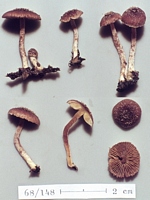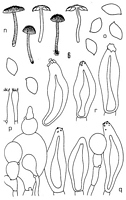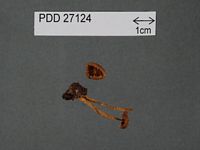|
 Inocybe destruens Inocybe destruens
BiostatusPresent in region - Indigenous. Endemic
Images (click to enlarge)
Caption: 68/148: Inocybe destruens
Owner: Egon Horak | 
Caption: Inocybe destruens (type): n, carpophores; o, spores; p, basidia; q, cheilocystidia;
r, pleurocystidia | 
Caption: Dried type specimen
Owner: Herb PDD |
Article: Horak, E. (1978) [1977]. Fungi Agaricini Novaezelandiae. VI. Inocybe (Fr.) Fr. and Astrosporina Schroeter. New Zealand Journal of Botany 15(4): 713–747 (http://www.rsnz.org/publish/abstracts.php).
Description: Pileus 10-20 mm diam., hemispherical to
convex, margin incurved; dark brown, fuscous; dry, covered at disc with coarse
erect or repent conical scales and squamules, which get smaller towards the
substriate margin, veil remnants absent. Lamellae adnexed to adnate, ventricose,
crowded (L-18, 1-3); pale yellow-brown when young, turning brown, edge concolorous
or albo-fimbriate. Stipe 15-35 x 2-3 mm, cylindrical, equal; concolorous with
pileus or paler; upper part pruinose, towards base covered with white to yellowish,
appressed, longitudinal fibrils from veil; dry, hollow, single and cespitose.
Context brown. Odour and taste pleasant, fruity, not distinctive.
Spores 7-8.5 x 4-5 µm, amygdaliform to sublimoniform,
brown, smooth. Basidia 22-28 x 6-7 µm, 4-spored. Cheilocystidia clavate to vesiculose,
thin-walled, often encrusted with brown pigment. Pleurocystidia 40-60 x 13-20
µm, broadly fusoid, very thick-walled (-8 µm diam.), yellow-brown, crystals
present. Caulocystidia -150 x -20 µm, subfusoid-cylindrical, metuloid, encrusted.
Cuticle a trichoderm of cylindrical hyphae (4-12 µm diam.), encrusted with yellow-brown
pigment. Clamp connections on septae.
Habitat: On rotten wood and bark of Dacrydium Cupressinum
in Nothofagus forest. New Zealand.
Notes: In the field I. destruens could be
taken as I. umbrosa Hk. because both species show deep brown to fuscous
colours on the pileus and the stipe of both taxa is obviously farinaceous. The
very thick-walled, rather stout, and yellow-brown pigmented pleurocystidia separate
I. destruens well from I. umbrosa, which may occasionally occur
on rotten wood and bark.
|